Medical Sensors Market
Medical Sensors Market Size and Share Forecast Outlook 2025 to 2035
Medical sensors market is projected to grow from USD 59.5 billion in 2025 to USD 346.1 billion by 2035, at a CAGR of 19.3%. Biosensors will dominate with a 44.0% market share, while surgical will lead the application segment with a 35.0% share.
Medical Sensors Market Forecast and Outlook 2025 to 2035
The global medical sensors market is projected to reach USD 346.1 billion by 2035, recording an absolute increase of USD 286.6 billion over the forecast period. The market is valued at USD 59.5 billion in 2025 and is set to rise at a CAGR of 19.3% during the assessment period.
The overall market size is expected to grow by nearly 5.8 times during the same period, supported by increasing prevalence of chronic diseases and aging populations driving demand for continuous patient monitoring solutions worldwide, creating substantial opportunities for sensor manufacturers developing miniaturized diagnostic technologies and increasing investments in wearable healthcare devices and remote patient monitoring infrastructure globally.
Quick Stats for Medical Sensors Market
- Medical Sensors Market Value (2025): USD 59.5 billion
- Medical Sensors Market Forecast Value (2035): USD 346.1 billion
- Medical Sensors Market Forecast CAGR: 19.3%
- Leading Product Type in Medical Sensors Market: Biosensors
- Key Growth Regions in Medical Sensors Market: Asia Pacific, North America, and Europe
- Top Players in Medical Sensors Market: Analog Devices Inc., GE Healthcare, Danaher Corporation, Honeywell International Inc., Sensirion AG, OmniVision Technologies Inc., Stryker Corporation, Avago Technologies Ltd.
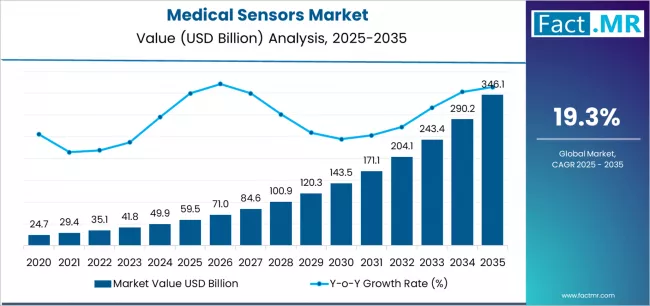
The healthcare industry faces mounting pressure to improve diagnostic accuracy while reducing hospitalization costs, with modern medical sensors providing documented clinical benefits of 40-60% improvement in early disease detection compared to traditional diagnostic methods. Rising adoption of connected healthcare systems and expanding telemedicine infrastructure across emerging economies create substantial opportunities for medical device manufacturers and technology providers. However, high development costs and stringent regulatory approval requirements may pose obstacles to market expansion.
The biosensors segment dominates market activity with approximately 44.0% share in 2025, driven by the extensive prevalence of diabetes requiring continuous glucose monitoring and personalized diagnostic capabilities across healthcare facilities worldwide. Healthcare providers increasingly recognize the clinical advantages of biosensor technologies, with typical diagnostic accuracy rates ranging from 85-95% through real-time biomarker detection and reduced laboratory processing time.
The surgical application segment demonstrates significant market presence with 35.0% share, supported by expanding robotic-assisted surgery adoption and precision instrument requirements in modern operating environments. Blood glucose sensors emerge as the leading biosensor category with 23.5% share within biosensors, reflecting the pharmaceutical and medical device industry focus on diabetes management combined with established patient acceptance.
Hospitals represent the most significant end-use application with 64.0% share in 2025, driven by comprehensive diagnostic equipment requirements and high-volume patient monitoring demands in institutional healthcare settings, though home healthcare emerges as the fastest-growing segment reflecting the shift toward decentralized patient care delivery models.
Regional dynamics show North America maintaining market leadership with USD 20.6 billion value in 2025, supported by advanced healthcare infrastructure and extensive FDA-approved medical device portfolios across USA and Canada. Asia Pacific demonstrates the strongest growth trajectory at 20.6% CAGR through 2035, driven by manufacturing capabilities and expanding elderly populations across China, Japan, and India.
Europe emphasizes chronic disease management and early diagnosis protocols, while Latin America focuses on medical device imports and home-care penetration. India leads country-level growth at 21.0% CAGR through digital health expansion and local production incentives, followed by China at 20.8% supported by state-backed manufacturing initiatives.
The competitive landscape features moderate concentration with Analog Devices Inc. holding 9.6% market share, while established players including GE Healthcare, Danaher Corporation, and Honeywell International Inc. compete through comprehensive sensor portfolios and advanced signal processing capabilities across diverse medical applications.
Medical Sensors Market Year-over-Year Forecast (2025-2035)
Between 2025 and 2029, the medical sensors market is projected to expand from USD 59.5 billion to USD 119.1 billion, resulting in a value increase of USD 59.6 billion, which represents 20.8% of the total forecast growth for the period. This phase of development will be shaped by rising demand for wearable diagnostic devices and continuous patient monitoring solutions, product innovation in biosensor technologies and miniaturized imaging systems, as well as expanding integration with artificial intelligence platforms and connected healthcare networks. Companies are establishing competitive positions through investment in specialized MEMS manufacturing capabilities, advanced signal processing technologies, and strategic market expansion across hospital, diagnostic, and home healthcare applications.
From 2029 to 2035, the market is forecast to grow from USD 119.1 billion to USD 346.1 billion, adding another USD 227.0 billion, which constitutes 79.2% of the overall expansion. This period is expected to be characterized by the expansion of specialized sensor applications, including advanced image sensors for minimally invasive procedures and next-generation biosensors tailored for personalized medicine requirements, strategic collaborations between medical device manufacturers and technology companies, and an enhanced focus on regulatory compliance and clinical validation standards. The growing emphasis on remote patient monitoring and artificial intelligence-enabled diagnostics will drive demand for comprehensive sensor solutions across diverse medical applications.
Medical Sensors Market Key Takeaways
| Metric | Value |
|---|---|
| Market Value (2025) | USD 59.5 billion |
| Market Forecast Value (2035) | USD 346.1 billion |
| Forecast CAGR (2025-2035) | 19.3% |
Why is the Medical Sensors Market Growing?
The medical sensors market grows by enabling healthcare providers and medical device manufacturers to optimize diagnostic capabilities while accessing advanced sensing technologies without substantial in-house research and development requirements. Hospital administrators and healthcare operators face mounting pressure to improve patient outcomes and operational efficiency while managing complex diagnostic accuracy requirements, with modern medical sensors typically providing 40-60% improvement in early disease detection compared to conventional diagnostic methods, making sensor integration essential for competitive clinical positioning. The healthcare industry's need for regulatory compliance and application-specific monitoring capabilities creates demand for comprehensive sensor solutions that can provide superior accuracy, maintain consistent performance standards, and ensure reliable operation without compromising patient safety or clinical decision-making processes.
Government initiatives promoting digital health transformation and preventive care models drive adoption in hospital systems, diagnostic laboratories, and home healthcare applications, where sensor performance has a direct impact on treatment outcomes and healthcare cost reduction. However, device complexity constraints during clinical integration projects and the technical requirements for compatibility with existing medical equipment infrastructure may limit accessibility among smaller healthcare facilities and developing regions with limited financial resources for sophisticated medical sensor deployments.
Segmental Analysis
The market is segmented by product, application, end use, and region. By product, the market is divided into biosensors, image sensors, pressure sensors, flow & temperature sensors, and others. Based on application, the market is categorized into surgical, diagnostics, therapeutics, and monitoring. By end use, the market includes hospitals, home healthcare, stand-alone clinics, and nursing homes/others. Regionally, the market is divided into North America, Europe, Asia Pacific, Latin America, and Middle East & Africa.
By Product, Which Segment Accounts for a Dominant Market Share?
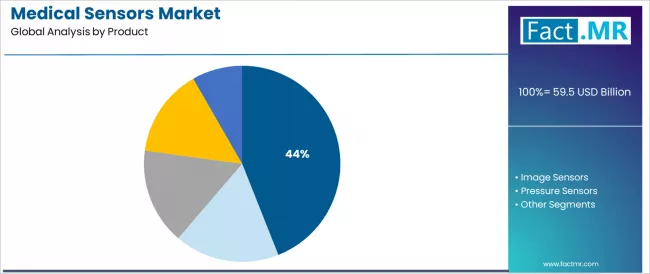
The biosensors segment represents the dominant force in the medical sensors market, capturing approximately 44.0% of total market share in 2025, projected to expand to 47.5% by 2035. This established product category encompasses solutions featuring real-time biomarker detection and continuous patient monitoring capabilities, including advanced glucose sensing technologies and specialized biochemical analysis platforms that enable superior diagnostic accuracy and patient management benefits across all medical applications. The biosensors segment's market leadership stems from its superior clinical advantages, with solutions capable of addressing diverse diagnostic requirements while maintaining consistent sensitivity standards and regulatory compliance across all healthcare environments.
The image sensors segment maintains a 14.0% market share in 2025, projected to reach 17.0% by 2035, serving healthcare facilities that require advanced visualization capabilities with enhanced imaging resolution for minimally invasive procedures and diagnostic imaging applications. These solutions offer high-definition image capture for endoscopic procedures while providing sufficient flexibility to meet contemporary miniaturization demands. The image sensors segment demonstrates the fastest growth trajectory among product categories, driven by expanding adoption in robotic surgery and diagnostic imaging innovations.
The pressure sensors segment holds 12.5% market share, addressing critical patient monitoring needs in intensive care and surgical environments. Flow & temperature sensors account for 11.0% share, while other sensors including accelerometers and SQUID technologies comprise 18.5% of the market.
Key technological advantages driving the biosensors segment include:
- Advanced biomarker recognition mechanisms with integrated signal amplification that enhance diagnostic sensitivity and ensure consistent clinical performance
- Established miniaturization frameworks allowing streamlined device integration across different medical applications without extensive hardware modifications
- Enhanced multi-analyte detection capabilities enabling diverse diagnostic configurations while maintaining measurement accuracy and system reliability
- Superior real-time monitoring providing optimal clinical insights for various patient management applications
Within the biosensors segment, blood glucose sensors command the leading position with 23.5% share, reflecting the medical device industry's focus on diabetes management solutions with established clinical validation and patient acceptance.
By Application, Which Segment Accounts for the Largest Market Share?
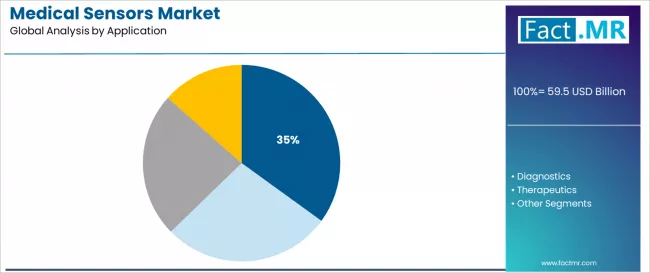
Surgical applications dominate the medical sensors market with approximately 35.0% market share in 2025, projected to decline slightly to 33.0% by 2035, reflecting the critical role of precision sensing systems in supporting minimally invasive procedures and robotic-assisted surgery requirements worldwide. The surgical applications segment's market leadership is reinforced by increasing surgical procedure volumes, complex navigation system requirements, and rising needs for real-time tissue characterization capabilities in operating room environments across developed and emerging markets.
The diagnostics segment represents the fastest-growing application category, demonstrating market share expansion from 30.0% in 2025 to 34.0% by 2035 through specialized requirements for point-of-care testing, wearable diagnostic device integration, and direct connectivity with electronic health record systems. This segment benefits from growing preventive healthcare demand that requires specific diagnostic accuracy requirements, rapid result delivery standards, and portable monitoring technology protocols in clinical and home healthcare markets.
The therapeutics segment holds 20.0% market share, serving pharmaceutical companies and medical device manufacturers with specialized drug delivery monitoring needs. Monitoring applications account for 15.0% share, addressing continuous patient surveillance requirements in critical care and chronic disease management.
Key market dynamics supporting application growth include:
- Surgical sensor expansion driven by rising minimally invasive procedure adoption and robotic surgery platform requirements, demanding advanced navigation solutions in expanding hospital markets
- Diagnostics modernization trends require flexible, integrated sensor systems for wearable health monitoring and point-of-care testing differentiation
- Integration of artificial intelligence technologies enabling advanced clinical decision support capabilities and automated diagnostic interpretation systems
- Growing emphasis on remote patient monitoring driving demand for specialized, validated sensor solutions without traditional hospitalization limitations
Within the surgical applications segment, robotic-assisted surgery sensors command 16.0% share, while wearable diagnostic devices lead the diagnostics segment with 18.5% share, reflecting the healthcare industry's shift toward ambulatory care models.
By End Use, Which Segment Accounts for a Significant Market Share?
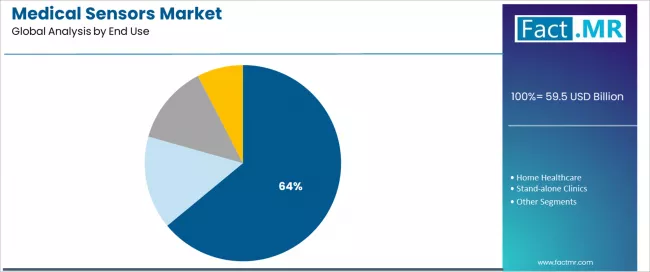
Hospitals represent the leading end-use application in the medical sensors market with approximately 64.0% market share in 2025, projected to decline to 56.0% by 2035, reflecting the extensive diagnostic and monitoring equipment requirements in institutional healthcare environments. The hospitals segment demonstrates consistent demand driven by equipment replacement cycles, advanced monitoring system upgrades, and regulatory compliance mandates across healthcare facility portfolios.
The home healthcare segment emerges as the fastest-growing end-use category, with market share expanding from 16.0% in 2025 to 26.0% by 2035, driven by aging demographics and increasing adoption of remote patient monitoring technologies. Home healthcare providers require portable sensor solutions capable of continuous health tracking while maintaining clinical-grade accuracy for chronic disease management and post-discharge care monitoring.
The stand-alone clinics segment maintains 12.0% market presence through outpatient diagnostic centers, specialty clinics, and ambulatory surgery facilities requiring cost-effective monitoring equipment. Nursing homes and other care facilities account for 8.0% share with stable contribution throughout the forecast period.
Key end-use dynamics include:
- Hospital equipment modernization accelerating across major healthcare systems with emphasis on integrated monitoring networks and operational efficiency
- Home healthcare expansion driving demand for wireless connectivity and user-friendly sensor interfaces in consumer-oriented medical devices
- Stand-alone clinic adoption requiring compact form factors and multi-parameter monitoring capabilities in space-constrained environments
- Nursing home applications prioritizing fall detection systems and vital sign monitoring in elderly care facilities
What are the Drivers, Restraints, and Key Trends of the Medical Sensors Market?
The market is driven by three concrete demand factors tied to healthcare delivery outcomes. First, increasing prevalence of chronic diseases and aging populations create escalating demand for continuous patient monitoring solutions, with chronic conditions affecting over 60% of adults globally, requiring comprehensive sensor-based healthcare interventions. Second, government initiatives promoting digital health transformation and telemedicine infrastructure drive increased adoption of connected medical sensors, with many countries implementing nationwide remote monitoring programs and reimbursement frameworks for sensor-enabled care delivery by 2030. Third, technological advancements in MEMS fabrication and wireless communication protocols enable more accurate and miniaturized sensor solutions that improve diagnostic capabilities while reducing device footprint and power consumption requirements.
Market restraints include high research and development costs and lengthy regulatory approval timelines for novel medical sensors that can challenge device manufacturers in developing compliant products, particularly in regions where clinical validation requirements remain stringent and reimbursement pathways uncertain. Data privacy concerns and cybersecurity vulnerabilities in connected medical devices pose another significant challenge, as networked sensors demand sophisticated encryption protocols and security frameworks, potentially affecting system costs and implementation complexity. Healthcare provider adoption barriers and workflow integration challenges across different clinical settings create additional operational obstacles for sensor manufacturers, demanding ongoing investment in user training programs and technical support infrastructure.
Key trends indicate accelerated sensor adoption in Asia-Pacific markets, particularly China and India, where medical device manufacturing expansion and healthcare digitalization initiatives drive comprehensive medical sensor deployment. Technology integration trends toward artificial intelligence-enabled diagnostics with predictive analytics capabilities, advanced miniaturization techniques, and multi-modal sensing platforms enable efficient clinical approaches that optimize patient outcomes and minimize diagnostic delays. However, the market thesis could face disruption if significant advances in non-invasive diagnostic imaging or major breakthroughs in molecular diagnostics reduce reliance on conventional sensor-based monitoring technologies.
Analysis of the Medical Sensors Market by Key Country
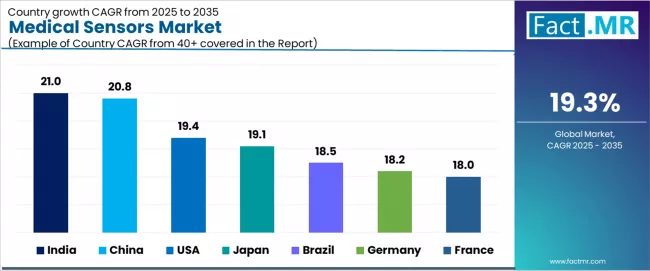
| Country | CAGR (2025-2035) |
|---|---|
| India | 21.0% |
| China | 20.8% |
| USA | 19.4% |
| Japan | 19.1% |
| Brazil | 18.5% |
| Germany | 18.2% |
| France | 18.0% |
| UK | 17.9% |
The global medical sensors market is expanding rapidly, with India leading at a 21.0% CAGR through 2035, driven by digital health transformation, expanding medical device manufacturing, and government production incentives. China follows at 20.8%, supported by state-backed sensor manufacturing initiatives, rising elderly populations, and comprehensive healthcare modernization programs.
The USA records 19.4%, reflecting robust adoption of FDA-approved digital therapeutics and sensor-enabled chronic care management systems. Japan grows at 19.1%, anchored by advanced wearable diagnostic devices and geriatric care innovations. Brazil advances at 18.5%, leveraging rapid hospital IoT infrastructure expansion.
Germany posts 18.2%, focusing on artificial intelligence integration in medical diagnostics, while France grows steadily at 18.0%, emphasizing early disease detection programs. UK demonstrates 17.9% growth through NHS digital patient monitoring initiatives.
India Leads Global Market Expansion
India demonstrates the strongest growth potential in the medical sensors market with a CAGR of 21.0% through 2035. The country's leadership position stems from aggressive digital health initiatives, expanding domestic medical device manufacturing capabilities, and comprehensive government production incentive schemes driving the adoption of advanced sensor technologies. Growth is concentrated in major metropolitan healthcare hubs and manufacturing centers, including Bangalore, Mumbai, Delhi, and Hyderabad, where medical device companies and hospital systems are implementing modern sensor-based diagnostic platforms for enhanced patient care and operational efficiency. Distribution channels through medical equipment distributors and hospital procurement networks expand sensor deployment across tertiary care facilities and diagnostic laboratory chains. The country's Department of Pharmaceuticals provides policy support for medical device localization, including comprehensive manufacturing incentive programs and regulatory fast-track mechanisms.
Key market factors:
- Medical device manufacturing expansion concentrated in technology corridors and special economic zones with comprehensive production infrastructure
- Government support through Make in India initiatives and medical device manufacturing incentives
- Comprehensive healthcare delivery ecosystem, including established hospital chains with proven technology adoption capabilities
- Technology integration featuring artificial intelligence diagnostic platforms, wireless connectivity standards, and cloud-based health monitoring systems
China Emerges as High-Growth Manufacturing Hub
In major healthcare and manufacturing centers including Beijing, Shanghai, Shenzhen, and Guangzhou, the adoption of comprehensive medical sensor solutions is accelerating across tertiary hospitals and medical device production facilities, driven by state-backed manufacturing policies and healthcare quality improvement mandates. The market demonstrates strong growth momentum with a CAGR of 20.8% through 2035, linked to comprehensive elderly care infrastructure development and increasing focus on preventive healthcare and chronic disease management solutions. Chinese healthcare providers and device manufacturers are implementing advanced sensor technologies and artificial intelligence diagnostic platforms to enhance clinical outcomes while meeting growing demand in expanding hospital and home healthcare sectors. The country's Healthy China 2030 initiative creates ongoing demand for medical sensors, while increasing emphasis on domestic technology self-sufficiency drives adoption of locally manufactured sensing solutions.
Key development areas:
- Tertiary hospitals and specialty medical centers leading sensor adoption with comprehensive connected health programs
- Medical device manufacturing clusters providing integrated sensor solutions with high production efficiency rates
- Technology partnerships between international sensor manufacturers and Chinese medical device enterprises expanding market reach
- Integration of 5G-enabled platforms and comprehensive remote patient monitoring systems
USA Shows Innovation Leadership
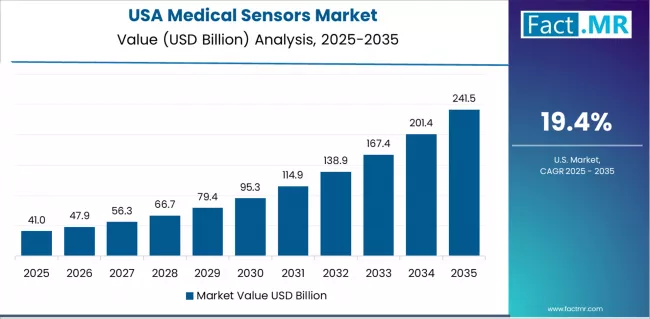
USA market expansion is driven by diverse healthcare demand, including academic medical centers implementing advanced monitoring systems and comprehensive sensor integration across multiple clinical specialties. The country demonstrates strong growth potential with a CAGR of 19.4% through 2035, supported by FDA digital health innovation programs and Centers for Medicare & Medicaid Services reimbursement expansion for remote monitoring technologies. American healthcare providers face implementation challenges related to data interoperability standards and electronic health record integration complexities, requiring coordinated deployment approaches and support from health information technology specialists. However, growing value-based care adoption and regulatory support for digital therapeutics create compelling business cases for medical sensor deployment, particularly in chronic disease management applications where continuous monitoring has a direct impact on patient outcomes and healthcare cost containment.
Market characteristics:
- Academic medical centers and integrated delivery networks showing robust sensor adoption with substantial annual investment in connected health infrastructure
- Regional deployment trends focused on remote patient monitoring programs in accountable care organizations and Medicare populations
- Future projections indicate the need for advanced cybersecurity infrastructure and clinical decision support system integration
- Growing emphasis on patient-generated health data and real-time clinical intervention competitiveness in healthcare quality metrics
Germany Demonstrates Engineering Excellence
The Germany market leads in precision sensor development based on integration with advanced manufacturing processes and rigorous quality control protocols for enhanced device reliability. The country shows strong potential with a CAGR of 18.2% through 2035, driven by the modernization of hospital diagnostic infrastructure and the expansion of artificial intelligence-enabled sensor deployments in major healthcare regions, including North Rhine-Westphalia, Bavaria, Baden-Württemberg, and Hesse. German healthcare providers are adopting intelligent medical sensors for diagnostic accuracy improvement and workflow optimization, particularly in regions with advanced medical technology clusters and clinical applications demanding comprehensive sensor integration. Medical device distribution channels through established hospital equipment suppliers and specialty distributors expand coverage across university hospitals and research medical centers.
Leading market segments:
- University hospitals and research institutions implementing comprehensive sensor networks and artificial intelligence diagnostic systems
- Technology partnerships with medical device manufacturers, achieving high clinical validation success rates
- Strategic collaborations between German engineering companies and international healthcare technology providers expanding innovation capabilities
- Focus on Industry 4.0 manufacturing standards and specialized medical device quality requirements
UK Emphasizes Digital Health Integration
In London, Manchester, Birmingham, and other major cities, NHS hospital trusts are implementing comprehensive medical sensor networks to modernize patient monitoring infrastructure and improve care delivery efficiency, with documented implementations showing substantial improvement in early warning score detection through continuous vital sign monitoring. The market shows strong growth potential with a CAGR of 17.9% through 2035, linked to the ongoing NHS digital transformation initiatives, Long Term Plan implementation, and emerging artificial intelligence diagnostic programs in major healthcare regions. British healthcare providers are adopting sensor-enabled monitoring systems and connected health platforms to enhance patient safety while maintaining standards demanded by National Institute for Health and Care Excellence guidelines and Care Quality Commission requirements. The country's established healthcare technology assessment framework creates ongoing demand for evidence-based sensor solutions that integrate with existing NHS digital infrastructure.
Market development factors:
- NHS foundation trusts and integrated care systems leading medical sensor implementation across UK
- NHS digital health programs providing funding support for remote monitoring and connected care initiatives
- Strategic partnerships between British healthcare technology companies and international sensor manufacturers expanding commercial capabilities
- Emphasis on interoperability standards and patient data portability across healthcare applications
Japan Shows Advanced Technology Integration
Japan's medical sensors market demonstrates sophisticated implementation focused on miniaturization excellence and precision manufacturing optimization, with documented integration of wearable diagnostic sensors achieving substantial improvement in elderly care monitoring across hospital and home healthcare facilities. The country maintains strong growth momentum with a CAGR of 19.1% through 2035, driven by healthcare facilities' emphasis on technological innovation and continuous quality improvement methodologies that align with Japanese manufacturing standards applied to medical device production. Major healthcare and industrial regions, including Kanto, Kansai, Chubu, and Kyushu, showcase advanced deployment of medical sensing technologies where monitoring systems integrate seamlessly with existing hospital information systems and comprehensive patient care protocols.
Key market characteristics:
- University hospitals and advanced treatment centers driving sophisticated sensor requirements with emphasis on miniaturization and reliability
- Quality partnerships enabling high device performance standards with comprehensive clinical validation programs
- Technology collaboration between Japanese electronics manufacturers and international medical device companies expanding product capabilities
- Emphasis on aging society healthcare solutions and continuous monitoring system optimization methodologies
Brazil Emphasizes Healthcare Infrastructure Modernization
In major metropolitan healthcare centers including São Paulo, Rio de Janeiro, Brasília, and Belo Horizonte, the adoption of modern medical sensor technologies is expanding across public and private hospital systems, driven by healthcare infrastructure investments and growing medical device market liberalization. The market demonstrates growth potential with a CAGR of 18.5% through 2035, linked to comprehensive hospital IoT infrastructure development and increasing focus on connected health solutions. Brazilian healthcare providers are implementing medical sensors and remote monitoring platforms to enhance clinical capabilities while meeting growing demand in expanding critical care and diagnostic sectors. The country's national health digitalization initiatives create ongoing demand for medical sensors, while increasing emphasis on reducing healthcare disparities drives adoption of affordable monitoring technologies.
Key development areas:
- Large hospital networks and private healthcare groups leading sensor adoption with expanding connected health programs
- Medical device distribution channels providing sensor solutions with growing clinical implementation capabilities
- Strategic partnerships between international medical device manufacturers and Brazilian healthcare distributors expanding market reach
- Integration of telemedicine platforms and comprehensive remote patient monitoring systems
Europe Market Split by Country
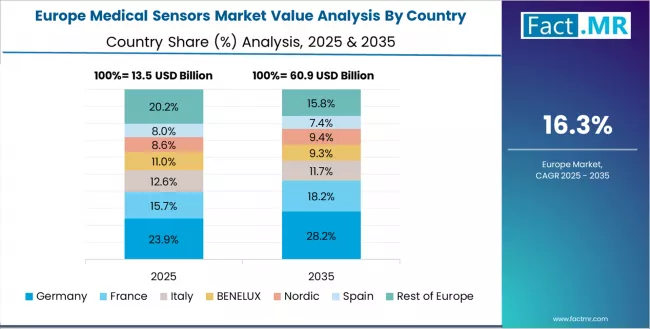
The medical sensors market in Europe is projected to grow from USD 13.0 billion in 2025 to USD 70.2 billion by 2035, registering a CAGR of 18.3% over the forecast period. Germany is expected to maintain its leadership position with a 29.5% market share in 2025, declining slightly to 28.8% by 2035, supported by its advanced medical device manufacturing infrastructure, precision engineering capabilities, and comprehensive healthcare technology networks serving major European markets.
UK follows with a 21.2% share in 2025, projected to reach 21.8% by 2035, driven by comprehensive NHS digital health programs and connected care initiatives across hospital trusts. France holds a 18.5% share in 2025, expected to maintain 18.3% by 2035 through the ongoing development of early disease detection programs and healthcare digitalization networks. Italy commands a 13.8% share, while Spain accounts for 10.2% in 2025. The Rest of Europe region is anticipated to gain momentum, expanding its collective share from 6.8% to 7.2% by 2035, attributed to increasing medical sensor adoption in Nordic healthcare systems and emerging Eastern European hospitals implementing connected health programs.
Precision Manufacturing Dominates Device Production in Japan
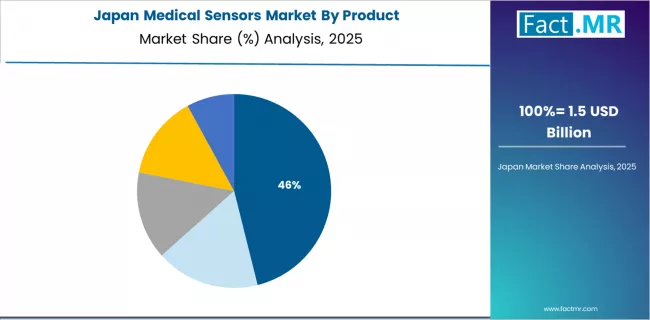
The Japanese medical sensors market demonstrates a mature and technology-focused landscape, characterized by sophisticated integration of miniaturized sensing systems with existing hospital monitoring infrastructure across university hospitals, advanced treatment centers, and elderly care facilities. Japan's emphasis on manufacturing excellence and device reliability drives demand for high-precision medical sensors that support comprehensive patient monitoring initiatives and aging society healthcare requirements. The market benefits from strong partnerships between international medical device providers like GE Healthcare, Analog Devices Inc., and domestic electronics manufacturers, including established technology companies and medical equipment specialists, creating comprehensive sensor ecosystems that prioritize device quality and clinical performance standards. Healthcare centers in major urban regions showcase advanced sensor implementations where monitoring systems achieve early detection improvements through integrated artificial intelligence analytics platforms.
Technology Companies Lead Sensor Innovation in South Korea
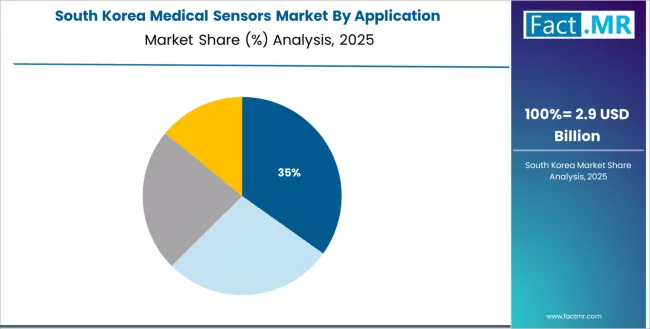
The South Korean medical sensors market is characterized by strong domestic technology company presence, with firms like Samsung Electronics and LG Electronics maintaining significant positions through comprehensive semiconductor capabilities and consumer electronics expertise applied to medical device development. The market is demonstrating a growing emphasis on wearable health monitoring devices and smartphone-integrated sensor platforms, as Korean healthcare consumers increasingly demand connected health solutions that integrate with digital lifestyle ecosystems deployed across metropolitan areas and technology-forward medical facilities. Local medical device manufacturers and regional electronics companies are gaining market share through strategic partnerships with global sensor providers, offering specialized capabilities including advanced CMOS image sensor development and biosensor miniaturization technologies. The competitive landscape shows increasing collaboration between multinational medical device companies and Korean technology enterprises, creating hybrid innovation models that combine international clinical expertise with local semiconductor manufacturing capabilities and consumer electronics market knowledge.
Competitive Landscape of the Medical Sensors Market
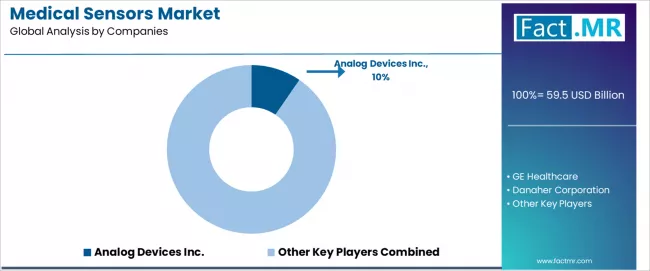
The medical sensors market features approximately 25-35 meaningful players with moderate concentration, where the top three companies control roughly 25-30% of global market share through established technology portfolios and extensive medical device distribution networks. Competition centers on sensor accuracy, miniaturization capabilities, and regulatory compliance rather than price competition alone.
Market leaders include Analog Devices Inc., GE Healthcare, and Danaher Corporation, which maintain competitive advantages through comprehensive sensor technology portfolios, advanced signal processing capabilities, and deep expertise in medical device integration, creating high customer loyalty among original equipment manufacturers and healthcare providers. These companies leverage established medical device partnerships and ongoing research and development investments to defend market positions while expanding into adjacent applications including artificial intelligence-enabled diagnostics and connected health monitoring systems.
Challengers encompass Honeywell International Inc. and Sensirion AG, which compete through specialized sensor technologies and strong presence in specific medical application segments. Medical device specialists, including OmniVision Technologies Inc., Stryker Corporation, and Avago Technologies Ltd., focus on particular sensor categories or clinical applications, offering differentiated capabilities in image sensing, surgical navigation, and optical sensing solutions.
Regional sensor manufacturers and emerging medical technology startups create competitive pressure through innovative sensing approaches and rapid product development capabilities, particularly in high-growth markets including China and India, where local manufacturing presence provides advantages in cost optimization and supply chain efficiency. Market dynamics favor companies that combine advanced sensor technologies with comprehensive technical support services that address the complete product lifecycle from design consultation through regulatory approval assistance and post-market clinical validation, while maintaining robust innovation pipelines addressing emerging healthcare trends including point-of-care diagnostics, artificial intelligence integration, and personalized medicine requirements in medical sensor applications.
Key Players in the Medical Sensors Market
- Analog Devices Inc.
- GE Healthcare
- Danaher Corporation
- Honeywell International Inc.
- Sensirion AG
- OmniVision Technologies Inc.
- Stryker Corporation
- Avago Technologies Ltd.
Scope of the Report
| Items | Values |
|---|---|
| Quantitative Units | USD 59.5 Billion |
| Product | Biosensors, Image Sensors, Pressure Sensors, Flow & Temperature Sensors, Others |
| Application | Surgical, Diagnostics, Therapeutics, Monitoring |
| End Use | Hospitals, Home Healthcare, Stand-alone Clinics, Nursing Homes/Others |
| Regions Covered | North America, Europe, Asia Pacific, Latin America, Middle East & Africa |
| Country Covered | USA, China, India, Japan, Germany, UK, France, Brazil, Canada, South Africa, and 40+ countries |
| Key Companies Profiled | Analog Devices Inc., GE Healthcare, Danaher Corporation, Honeywell International Inc., Sensirion AG, OmniVision Technologies Inc., Stryker Corporation, Avago Technologies Ltd. |
| Additional Attributes | Revenue analysis by product and application categories, regional sensor adoption trends across North America, Europe, and Asia Pacific, competitive landscape with medical device manufacturers and technology companies, sensor specifications and performance requirements, integration with artificial intelligence diagnostic initiatives and connected health platforms, innovations in MEMS technology and wireless sensing systems, and development of specialized applications with miniaturization and clinical accuracy optimization capabilities. |
Medical Sensors Market by Segments
-
Product :
- Biosensors
- Image Sensors
- Pressure Sensors
- Flow & Temperature Sensors
- Others (Accelerometers, SQUID, etc.)
-
Application :
- Surgical
- Diagnostics
- Therapeutics
- Monitoring
-
End Use :
- Hospitals
- Home Healthcare
- Stand-alone Clinics
- Nursing Homes/Others
-
Region :
- North America
- USA
- Canada
- Mexico
- Europe
- Germany
- UK
- France
- Italy
- Spain
- Nordic
- Rest of Europe
- Asia Pacific
- China
- Japan
- India
- South Korea
- Australia & New Zealand
- ASEAN
- Rest of Asia Pacific
- Latin America
- Brazil
- Argentina
- Rest of Latin America
- Middle East & Africa
- Kingdom of Saudi Arabia
- United Arab Emirates
- South Africa
- Rest of Middle East & Africa
- North America
Table of Content
- Executive Summary
- Global Market Outlook
- Demand to side Trends
- Supply to side Trends
- Technology Roadmap Analysis
- Analysis and Recommendations
- Market Overview
- Market Coverage / Taxonomy
- Market Definition / Scope / Limitations
- Market Background
- Market Dynamics
- Drivers
- Restraints
- Opportunity
- Trends
- Scenario Forecast
- Demand in Optimistic Scenario
- Demand in Likely Scenario
- Demand in Conservative Scenario
- Opportunity Map Analysis
- Product Life Cycle Analysis
- Supply Chain Analysis
- Investment Feasibility Matrix
- Value Chain Analysis
- PESTLE and Porter’s Analysis
- Regulatory Landscape
- Regional Parent Market Outlook
- Production and Consumption Statistics
- Import and Export Statistics
- Market Dynamics
- Global Market Analysis 2020 to 2024 and Forecast, 2025 to 2035
- Historical Market Size Value (USD Million) Analysis, 2020 to 2024
- Current and Future Market Size Value (USD Million) Projections, 2025 to 2035
- Y to o to Y Growth Trend Analysis
- Absolute $ Opportunity Analysis
- Global Market Pricing Analysis 2020 to 2024 and Forecast 2025 to 2035
- Global Market Analysis 2020 to 2024 and Forecast 2025 to 2035, By Product
- Introduction / Key Findings
- Historical Market Size Value (USD Million) Analysis By Product, 2020 to 2024
- Current and Future Market Size Value (USD Million) Analysis and Forecast By Product, 2025 to 2035
- Biosensors
- Image Sensors
- Pressure Sensors
- Flow & Temperature Sensors
- Others (Accelerometers, SQUID, etc.)
- Y to o to Y Growth Trend Analysis By Product, 2020 to 2024
- Absolute $ Opportunity Analysis By Product, 2025 to 2035
- Global Market Analysis 2020 to 2024 and Forecast 2025 to 2035, By Application
- Introduction / Key Findings
- Historical Market Size Value (USD Million) Analysis By Application, 2020 to 2024
- Current and Future Market Size Value (USD Million) Analysis and Forecast By Application, 2025 to 2035
- Surgical
- Diagnostics
- Therapeutics
- Monitoring
- Y to o to Y Growth Trend Analysis By Application, 2020 to 2024
- Absolute $ Opportunity Analysis By Application, 2025 to 2035
- Global Market Analysis 2020 to 2024 and Forecast 2025 to 2035, By End Use
- Introduction / Key Findings
- Historical Market Size Value (USD Million) Analysis By End Use, 2020 to 2024
- Current and Future Market Size Value (USD Million) Analysis and Forecast By End Use, 2025 to 2035
- Hospitals
- Home Healthcare
- Stand-alone Clinics
- Nursing Homes/Others
- Y to o to Y Growth Trend Analysis By End Use, 2020 to 2024
- Absolute $ Opportunity Analysis By End Use, 2025 to 2035
- Global Market Analysis 2020 to 2024 and Forecast 2025 to 2035, By Region
- Introduction
- Historical Market Size Value (USD Million) Analysis By Region, 2020 to 2024
- Current Market Size Value (USD Million) Analysis and Forecast By Region, 2025 to 2035
- North America
- Latin America
- Western Europe
- Eastern Europe
- East Asia
- South Asia and Pacific
- Middle East & Africa
- Market Attractiveness Analysis By Region
- North America Market Analysis 2020 to 2024 and Forecast 2025 to 2035, By Country
- Historical Market Size Value (USD Million) Trend Analysis By Market Taxonomy, 2020 to 2024
- Market Size Value (USD Million) Forecast By Market Taxonomy, 2025 to 2035
- By Country
- USA
- Canada
- Mexico
- By Product
- By Application
- By End Use
- By Country
- Market Attractiveness Analysis
- By Country
- By Product
- By Application
- By End Use
- Key Takeaways
- Latin America Market Analysis 2020 to 2024 and Forecast 2025 to 2035, By Country
- Historical Market Size Value (USD Million) Trend Analysis By Market Taxonomy, 2020 to 2024
- Market Size Value (USD Million) Forecast By Market Taxonomy, 2025 to 2035
- By Country
- Brazil
- Chile
- Rest of Latin America
- By Product
- By Application
- By End Use
- By Country
- Market Attractiveness Analysis
- By Country
- By Product
- By Application
- By End Use
- Key Takeaways
- Western Europe Market Analysis 2020 to 2024 and Forecast 2025 to 2035, By Country
- Historical Market Size Value (USD Million) Trend Analysis By Market Taxonomy, 2020 to 2024
- Market Size Value (USD Million) Forecast By Market Taxonomy, 2025 to 2035
- By Country
- Germany
- UK
- Italy
- Spain
- France
- Nordic
- BENELUX
- Rest of Western Europe
- By Product
- By Application
- By End Use
- By Country
- Market Attractiveness Analysis
- By Country
- By Product
- By Application
- By End Use
- Key Takeaways
- Eastern Europe Market Analysis 2020 to 2024 and Forecast 2025 to 2035, By Country
- Historical Market Size Value (USD Million) Trend Analysis By Market Taxonomy, 2020 to 2024
- Market Size Value (USD Million) Forecast By Market Taxonomy, 2025 to 2035
- By Country
- Russia
- Poland
- Hungary
- Balkan & Baltic
- Rest of Eastern Europe
- By Product
- By Application
- By End Use
- By Country
- Market Attractiveness Analysis
- By Country
- By Product
- By Application
- By End Use
- Key Takeaways
- East Asia Market Analysis 2020 to 2024 and Forecast 2025 to 2035, By Country
- Historical Market Size Value (USD Million) Trend Analysis By Market Taxonomy, 2020 to 2024
- Market Size Value (USD Million) Forecast By Market Taxonomy, 2025 to 2035
- By Country
- China
- Japan
- South Korea
- By Product
- By Application
- By End Use
- By Country
- Market Attractiveness Analysis
- By Country
- By Product
- By Application
- By End Use
- Key Takeaways
- South Asia and Pacific Market Analysis 2020 to 2024 and Forecast 2025 to 2035, By Country
- Historical Market Size Value (USD Million) Trend Analysis By Market Taxonomy, 2020 to 2024
- Market Size Value (USD Million) Forecast By Market Taxonomy, 2025 to 2035
- By Country
- India
- ASEAN
- Australia & New Zealand
- Rest of South Asia and Pacific
- By Product
- By Application
- By End Use
- By Country
- Market Attractiveness Analysis
- By Country
- By Product
- By Application
- By End Use
- Key Takeaways
- Middle East & Africa Market Analysis 2020 to 2024 and Forecast 2025 to 2035, By Country
- Historical Market Size Value (USD Million) Trend Analysis By Market Taxonomy, 2020 to 2024
- Market Size Value (USD Million) Forecast By Market Taxonomy, 2025 to 2035
- By Country
- Kingdom of Saudi Arabia
- Other GCC Countries
- Turkiye
- South Africa
- Other African Union
- Rest of Middle East & Africa
- By Product
- By Application
- By End Use
- By Country
- Market Attractiveness Analysis
- By Country
- By Product
- By Application
- By End Use
- Key Takeaways
- Key Countries Market Analysis
- USA
- Pricing Analysis
- Market Share Analysis, 2024
- By Product
- By Application
- By End Use
- Canada
- Pricing Analysis
- Market Share Analysis, 2024
- By Product
- By Application
- By End Use
- Mexico
- Pricing Analysis
- Market Share Analysis, 2024
- By Product
- By Application
- By End Use
- Brazil
- Pricing Analysis
- Market Share Analysis, 2024
- By Product
- By Application
- By End Use
- Chile
- Pricing Analysis
- Market Share Analysis, 2024
- By Product
- By Application
- By End Use
- Germany
- Pricing Analysis
- Market Share Analysis, 2024
- By Product
- By Application
- By End Use
- UK
- Pricing Analysis
- Market Share Analysis, 2024
- By Product
- By Application
- By End Use
- Italy
- Pricing Analysis
- Market Share Analysis, 2024
- By Product
- By Application
- By End Use
- Spain
- Pricing Analysis
- Market Share Analysis, 2024
- By Product
- By Application
- By End Use
- France
- Pricing Analysis
- Market Share Analysis, 2024
- By Product
- By Application
- By End Use
- India
- Pricing Analysis
- Market Share Analysis, 2024
- By Product
- By Application
- By End Use
- ASEAN
- Pricing Analysis
- Market Share Analysis, 2024
- By Product
- By Application
- By End Use
- Australia & New Zealand
- Pricing Analysis
- Market Share Analysis, 2024
- By Product
- By Application
- By End Use
- China
- Pricing Analysis
- Market Share Analysis, 2024
- By Product
- By Application
- By End Use
- Japan
- Pricing Analysis
- Market Share Analysis, 2024
- By Product
- By Application
- By End Use
- South Korea
- Pricing Analysis
- Market Share Analysis, 2024
- By Product
- By Application
- By End Use
- Russia
- Pricing Analysis
- Market Share Analysis, 2024
- By Product
- By Application
- By End Use
- Poland
- Pricing Analysis
- Market Share Analysis, 2024
- By Product
- By Application
- By End Use
- Hungary
- Pricing Analysis
- Market Share Analysis, 2024
- By Product
- By Application
- By End Use
- Kingdom of Saudi Arabia
- Pricing Analysis
- Market Share Analysis, 2024
- By Product
- By Application
- By End Use
- Turkiye
- Pricing Analysis
- Market Share Analysis, 2024
- By Product
- By Application
- By End Use
- South Africa
- Pricing Analysis
- Market Share Analysis, 2024
- By Product
- By Application
- By End Use
- USA
- Market Structure Analysis
- Competition Dashboard
- Competition Benchmarking
- Market Share Analysis of Top Players
- By Regional
- By Product
- By Application
- By End Use
- Competition Analysis
- Competition Deep Dive
- Analog Devices Inc.
- Overview
- Product Portfolio
- Profitability by Market Segments (Product/Age /Sales Channel/Region)
- Sales Footprint
- Strategy Overview
- Marketing Strategy
- Product Strategy
- Channel Strategy
- GE Healthcare
- Danaher Corporation
- Honeywell International Inc.
- Sensirion AG
- OmniVision Technologies Inc.
- Stryker Corporation
- Avago Technologies Ltd.
- Analog Devices Inc.
- Competition Deep Dive
- Assumptions & Acronyms Used
- Research Methodology
List Of Table
- Table 1: Global Market Value (USD Million) Forecast by Region, 2020 to 2035
- Table 2: Global Market Value (USD Million) Forecast by Product, 2020 to 2035
- Table 3: Global Market Value (USD Million) Forecast by Application, 2020 to 2035
- Table 4: Global Market Value (USD Million) Forecast by End Use, 2020 to 2035
- Table 5: North America Market Value (USD Million) Forecast by Country, 2020 to 2035
- Table 6: North America Market Value (USD Million) Forecast by Product, 2020 to 2035
- Table 7: North America Market Value (USD Million) Forecast by Application, 2020 to 2035
- Table 8: North America Market Value (USD Million) Forecast by End Use, 2020 to 2035
- Table 9: Latin America Market Value (USD Million) Forecast by Country, 2020 to 2035
- Table 10: Latin America Market Value (USD Million) Forecast by Product, 2020 to 2035
- Table 11: Latin America Market Value (USD Million) Forecast by Application, 2020 to 2035
- Table 12: Latin America Market Value (USD Million) Forecast by End Use, 2020 to 2035
- Table 13: Western Europe Market Value (USD Million) Forecast by Country, 2020 to 2035
- Table 14: Western Europe Market Value (USD Million) Forecast by Product, 2020 to 2035
- Table 15: Western Europe Market Value (USD Million) Forecast by Application, 2020 to 2035
- Table 16: Western Europe Market Value (USD Million) Forecast by End Use, 2020 to 2035
- Table 17: Eastern Europe Market Value (USD Million) Forecast by Country, 2020 to 2035
- Table 18: Eastern Europe Market Value (USD Million) Forecast by Product, 2020 to 2035
- Table 19: Eastern Europe Market Value (USD Million) Forecast by Application, 2020 to 2035
- Table 20: Eastern Europe Market Value (USD Million) Forecast by End Use, 2020 to 2035
- Table 21: East Asia Market Value (USD Million) Forecast by Country, 2020 to 2035
- Table 22: East Asia Market Value (USD Million) Forecast by Product, 2020 to 2035
- Table 23: East Asia Market Value (USD Million) Forecast by Application, 2020 to 2035
- Table 24: East Asia Market Value (USD Million) Forecast by End Use, 2020 to 2035
- Table 25: South Asia and Pacific Market Value (USD Million) Forecast by Country, 2020 to 2035
- Table 26: South Asia and Pacific Market Value (USD Million) Forecast by Product, 2020 to 2035
- Table 27: South Asia and Pacific Market Value (USD Million) Forecast by Application, 2020 to 2035
- Table 28: South Asia and Pacific Market Value (USD Million) Forecast by End Use, 2020 to 2035
- Table 29: Middle East & Africa Market Value (USD Million) Forecast by Country, 2020 to 2035
- Table 30: Middle East & Africa Market Value (USD Million) Forecast by Product, 2020 to 2035
- Table 31: Middle East & Africa Market Value (USD Million) Forecast by Application, 2020 to 2035
- Table 32: Middle East & Africa Market Value (USD Million) Forecast by End Use, 2020 to 2035
List Of Figures
- Figure 1: Global Market Pricing Analysis
- Figure 2: Global Market Value (USD Million) Forecast 2020 to 2035
- Figure 3: Global Market Value Share and BPS Analysis by Product, 2025 and 2035
- Figure 4: Global Market Y to o to Y Growth Comparison by Product, 2025 to 2035
- Figure 5: Global Market Attractiveness Analysis by Product
- Figure 6: Global Market Value Share and BPS Analysis by Application, 2025 and 2035
- Figure 7: Global Market Y to o to Y Growth Comparison by Application, 2025 to 2035
- Figure 8: Global Market Attractiveness Analysis by Application
- Figure 9: Global Market Value Share and BPS Analysis by End Use, 2025 and 2035
- Figure 10: Global Market Y to o to Y Growth Comparison by End Use, 2025 to 2035
- Figure 11: Global Market Attractiveness Analysis by End Use
- Figure 12: Global Market Value (USD Million) Share and BPS Analysis by Region, 2025 and 2035
- Figure 13: Global Market Y to o to Y Growth Comparison by Region, 2025 to 2035
- Figure 14: Global Market Attractiveness Analysis by Region
- Figure 15: North America Market Incremental Dollar Opportunity, 2025 to 2035
- Figure 16: Latin America Market Incremental Dollar Opportunity, 2025 to 2035
- Figure 17: Western Europe Market Incremental Dollar Opportunity, 2025 to 2035
- Figure 18: Eastern Europe Market Incremental Dollar Opportunity, 2025 to 2035
- Figure 19: East Asia Market Incremental Dollar Opportunity, 2025 to 2035
- Figure 20: South Asia and Pacific Market Incremental Dollar Opportunity, 2025 to 2035
- Figure 21: Middle East & Africa Market Incremental Dollar Opportunity, 2025 to 2035
- Figure 22: North America Market Value Share and BPS Analysis by Country, 2025 and 2035
- Figure 23: North America Market Value Share and BPS Analysis by Product, 2025 and 2035
- Figure 24: North America Market Y to o to Y Growth Comparison by Product, 2025 to 2035
- Figure 25: North America Market Attractiveness Analysis by Product
- Figure 26: North America Market Value Share and BPS Analysis by Application, 2025 and 2035
- Figure 27: North America Market Y to o to Y Growth Comparison by Application, 2025 to 2035
- Figure 28: North America Market Attractiveness Analysis by Application
- Figure 29: North America Market Value Share and BPS Analysis by End Use, 2025 and 2035
- Figure 30: North America Market Y to o to Y Growth Comparison by End Use, 2025 to 2035
- Figure 31: North America Market Attractiveness Analysis by End Use
- Figure 32: Latin America Market Value Share and BPS Analysis by Country, 2025 and 2035
- Figure 33: Latin America Market Value Share and BPS Analysis by Product, 2025 and 2035
- Figure 34: Latin America Market Y to o to Y Growth Comparison by Product, 2025 to 2035
- Figure 35: Latin America Market Attractiveness Analysis by Product
- Figure 36: Latin America Market Value Share and BPS Analysis by Application, 2025 and 2035
- Figure 37: Latin America Market Y to o to Y Growth Comparison by Application, 2025 to 2035
- Figure 38: Latin America Market Attractiveness Analysis by Application
- Figure 39: Latin America Market Value Share and BPS Analysis by End Use, 2025 and 2035
- Figure 40: Latin America Market Y to o to Y Growth Comparison by End Use, 2025 to 2035
- Figure 41: Latin America Market Attractiveness Analysis by End Use
- Figure 42: Western Europe Market Value Share and BPS Analysis by Country, 2025 and 2035
- Figure 43: Western Europe Market Value Share and BPS Analysis by Product, 2025 and 2035
- Figure 44: Western Europe Market Y to o to Y Growth Comparison by Product, 2025 to 2035
- Figure 45: Western Europe Market Attractiveness Analysis by Product
- Figure 46: Western Europe Market Value Share and BPS Analysis by Application, 2025 and 2035
- Figure 47: Western Europe Market Y to o to Y Growth Comparison by Application, 2025 to 2035
- Figure 48: Western Europe Market Attractiveness Analysis by Application
- Figure 49: Western Europe Market Value Share and BPS Analysis by End Use, 2025 and 2035
- Figure 50: Western Europe Market Y to o to Y Growth Comparison by End Use, 2025 to 2035
- Figure 51: Western Europe Market Attractiveness Analysis by End Use
- Figure 52: Eastern Europe Market Value Share and BPS Analysis by Country, 2025 and 2035
- Figure 53: Eastern Europe Market Value Share and BPS Analysis by Product, 2025 and 2035
- Figure 54: Eastern Europe Market Y to o to Y Growth Comparison by Product, 2025 to 2035
- Figure 55: Eastern Europe Market Attractiveness Analysis by Product
- Figure 56: Eastern Europe Market Value Share and BPS Analysis by Application, 2025 and 2035
- Figure 57: Eastern Europe Market Y to o to Y Growth Comparison by Application, 2025 to 2035
- Figure 58: Eastern Europe Market Attractiveness Analysis by Application
- Figure 59: Eastern Europe Market Value Share and BPS Analysis by End Use, 2025 and 2035
- Figure 60: Eastern Europe Market Y to o to Y Growth Comparison by End Use, 2025 to 2035
- Figure 61: Eastern Europe Market Attractiveness Analysis by End Use
- Figure 62: East Asia Market Value Share and BPS Analysis by Country, 2025 and 2035
- Figure 63: East Asia Market Value Share and BPS Analysis by Product, 2025 and 2035
- Figure 64: East Asia Market Y to o to Y Growth Comparison by Product, 2025 to 2035
- Figure 65: East Asia Market Attractiveness Analysis by Product
- Figure 66: East Asia Market Value Share and BPS Analysis by Application, 2025 and 2035
- Figure 67: East Asia Market Y to o to Y Growth Comparison by Application, 2025 to 2035
- Figure 68: East Asia Market Attractiveness Analysis by Application
- Figure 69: East Asia Market Value Share and BPS Analysis by End Use, 2025 and 2035
- Figure 70: East Asia Market Y to o to Y Growth Comparison by End Use, 2025 to 2035
- Figure 71: East Asia Market Attractiveness Analysis by End Use
- Figure 72: South Asia and Pacific Market Value Share and BPS Analysis by Country, 2025 and 2035
- Figure 73: South Asia and Pacific Market Value Share and BPS Analysis by Product, 2025 and 2035
- Figure 74: South Asia and Pacific Market Y to o to Y Growth Comparison by Product, 2025 to 2035
- Figure 75: South Asia and Pacific Market Attractiveness Analysis by Product
- Figure 76: South Asia and Pacific Market Value Share and BPS Analysis by Application, 2025 and 2035
- Figure 77: South Asia and Pacific Market Y to o to Y Growth Comparison by Application, 2025 to 2035
- Figure 78: South Asia and Pacific Market Attractiveness Analysis by Application
- Figure 79: South Asia and Pacific Market Value Share and BPS Analysis by End Use, 2025 and 2035
- Figure 80: South Asia and Pacific Market Y to o to Y Growth Comparison by End Use, 2025 to 2035
- Figure 81: South Asia and Pacific Market Attractiveness Analysis by End Use
- Figure 82: Middle East & Africa Market Value Share and BPS Analysis by Country, 2025 and 2035
- Figure 83: Middle East & Africa Market Value Share and BPS Analysis by Product, 2025 and 2035
- Figure 84: Middle East & Africa Market Y to o to Y Growth Comparison by Product, 2025 to 2035
- Figure 85: Middle East & Africa Market Attractiveness Analysis by Product
- Figure 86: Middle East & Africa Market Value Share and BPS Analysis by Application, 2025 and 2035
- Figure 87: Middle East & Africa Market Y to o to Y Growth Comparison by Application, 2025 to 2035
- Figure 88: Middle East & Africa Market Attractiveness Analysis by Application
- Figure 89: Middle East & Africa Market Value Share and BPS Analysis by End Use, 2025 and 2035
- Figure 90: Middle East & Africa Market Y to o to Y Growth Comparison by End Use, 2025 to 2035
- Figure 91: Middle East & Africa Market Attractiveness Analysis by End Use
- Figure 92: Global Market - Tier Structure Analysis
- Figure 93: Global Market - Company Share Analysis
- FAQs -
How big is the medical sensors market in 2025?
The global medical sensors market is estimated to be valued at USD 59.5 billion in 2025.
What will be the size of medical sensors market in 2035?
The market size for the medical sensors market is projected to reach USD 346.1 billion by 2035.
How much will be the medical sensors market growth between 2025 and 2035?
The medical sensors market is expected to grow at a 19.3% CAGR between 2025 and 2035.
What are the key product types in the medical sensors market?
The key product types in medical sensors market are biosensors , image sensors , pressure sensors , flow & temperature sensors and others (accelerometers, squid, etc.).
Which application segment to contribute significant share in the medical sensors market in 2025?
In terms of application, surgical segment to command 35.0% share in the medical sensors market in 2025.